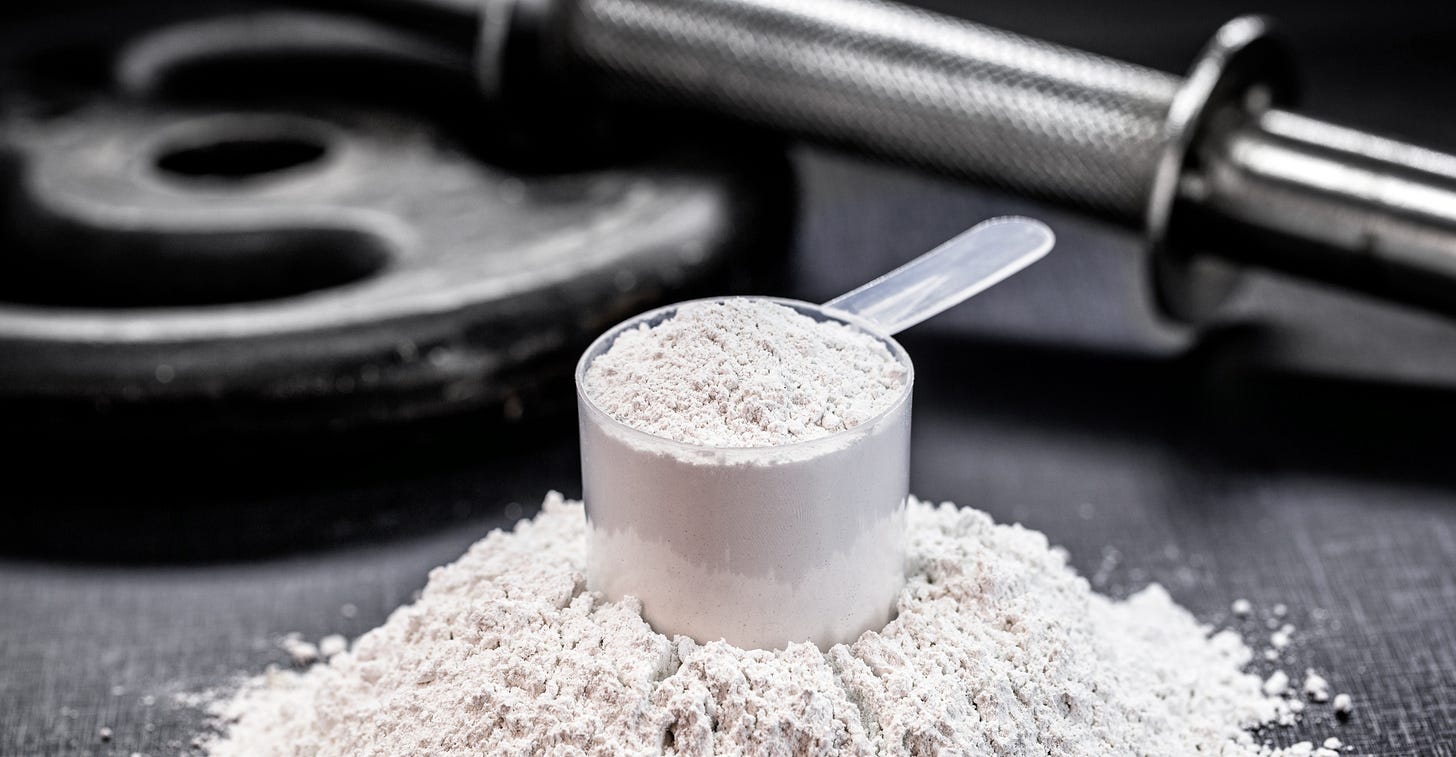Protein's BFF: Does creatine belong in your routine?
You thought it was just for gym bros. Here's why you should pay attention (especially if you're in some phase of menopause).
This issue is sponsored by the new DAILY BAR from Kreatures of Habit
I’ve written about protein extensively. I’ve shared why it’s important (especially if you have or once had a uterus), how much you might need, and how to craft your own high-protein meals and snacks.
But there’s another protein-adjacent compound that is also proving beneficial for women, no matter your age. It’s the most well-researched and scientifically-backed supplement ever. It’s also incredibly safe, and generally well-tolerated.
You’ve definitely heard of it. You may have thought, “that’s just for gym bros”—but it’s not. At least, not anymore.
What do you really know about creatine?
Creatine is a naturally-occurring compound made up of three amino acids (arginine, glycine, and methionine) and is stored mostly in your muscles and brain. You can find these amino acids in animal protein; in fact, omnivores generally get 1-2 grams a day from the foods we eat.
There are a few common myths surrounding creatine, so let’s get those out of the way:
Creatine is a steroid. It’s not! Creatine is naturally synthesized in the body from amino acids, and is also found in animal protein (muscle meat).
Creatine damages the kidneys. Nope! Studies show that long-term creatine use doesn’t harm the kidneys of healthy adults. (It’s always best to check with your doctor before taking any new supplement, and creatine might not be right for those with kidney issues.)
Creatine causes weight gain. It’s a myth that creatine leads to water retention. In fact, there is no strong evidence to support this. If you do notice water retention, as some have reported, it’s a temporary effect, not weight gain.
Creatine is bad for digestion. Some experience mild digestive distress when taking creatine, but that usually stems from taking a large dose all at once. Starting with a lower dose and gradually increasing, or splitting up your dose throughout the day, helps most people avoid this.
All forms of creatine are the same. While there are multiple forms, creatine monohydrate is the most studied, safe, and proven. It’s the form you’ll find in most creatine supplements. Creatine hydrochloride (HCL) is also gaining in popularity, some find they tolerate this form better. However, it’s far less common, more expensive, and it hasn’t been proven to offer any additional benefits.
Supplementing with creatine, especially in menopause
While we may get a gram or two of creatine from our omnivorous diets, supplementing with additional creatine monohydrate has proven benefits for strength, power, speed, and recovery from exercise. (If you’re vegan, this is especially important, as creatine isn’t found in plants.) It’s also long been recommended for adults experiencing muscle loss… the kind of muscle loss you’d experience in menopause.
Menopause brings a huge shift in just about every body system. Those going through “the change” experience changes in hunger cues, muscle mass, fat distribution, sleep, mood, and focus. In addition, as estrogen declines, it leads to the loss of muscle mass and strength, an increase in fatigue, loss of balance, a drop in metabolic rate, accelerated bone turnover, and an increased risk of osteoporosis. (Fun, right?)
Studies on creatine monohydrate and exercise are numerous, and the benefits are conclusive. But now, thanks to recent studies (including a new randomized controlled trial done with menopausal women), we’re seeing strong emerging evidence for other benefits:
Energy. Creatine can reduce fatigue and improve energy, especially during exercise or with medical conditions like long COVID.
Focus and attention. Creatine can improve your performance on focus-driven tasks. This has proven especially true during periods of sleep deprivation.
Enhanced memory. Creatine increases ATP (energy) to the brain, thus improving memory. This is especially significant in older adults.
Reducing mental fatigue. Creatine is showing real promise in enhancing concentration and processing speed and reducing “brain fog.”
Research in these areas are ongoing, but the results thus far are incredibly promising, especially for those in or approaching menopause. Of course, creatine alone won’t achieve all of this! We still need strength training, a balanced diet, and a healthy lifestyle. But adding creatine to your diet and exercise routine can provide benefits that may help you move through every life stage with more ease, strength, and health.
The generally recommended dose for supplementing with creatine monohydrate is 3-5 grams per day. This dosage, when taken consistently, allows most people to see benefits within a month, especially when combined with resistance training.
Protein and creatine, made easy and delicious
I’ve sung the praises of my favorite high-protein oatmeal, MEAL ONE from Kreatures of Habit, for years. Last week, they dropped their newest work of art—and it’s both high-protein and packed with creatine monohydrate.
The DAILY BAR from Kreatures of Habit is a true mini-meal with a major bonus—3 grams of creatine monohydrate. The DAILY BAR features:
A whopping 20(!) grams of protein
An impressive 9-10 grams of fiber
Just 1-3 grams of added sugar
The main character… 3 grams of creatine monohydrate
Now, you can contribute substantially to your daily protein intake and hit your daily dose of creatine in just one bar. Also, importantly—it tastes good. Really good. And creatine generally… doesn’t.
Creatine, reimagined
Creatine monohydrate naturally has a bitter, chalky taste. If degraded, as it can with heat, you can add “sour” to that list. It’s hard to make it taste good.
In full transparency, when I first tasted the bar, I expected the creatine to come through. (Many brands try to mask it with other ingredients, but it’s almost always still there.) I was shocked that I couldn’t taste it at all. I’d never know the DAILY BAR had that much creatine if it wasn’t right there on the label. (The fact that it’s never heated, thus avoiding the risk of degradation, surely helps.)
I’m also incredibly sensitive to flavors that taste manufactured. But the Chocolate Peanut Butter bar tasted like peanut butter. Actual peanut butter, not peanut butter flavor. And the chocolate! It has a delicious drizzle of high-quality, tempered chocolate over the top. And the crunch! This flavor has chocolate chips and rice puffs. So many protein bars are texturally one-note, but not this one.
Taste is subjective, but I also expected it to taste way sweeter, and I honestly wasn’t looking forward to that. (I’m not a big sweets person.) Again, I was pleasantly surprised! The DAILY BAR offers a satisfying sweetness, but has a great balance with the peanut butter. In fact, if you like peanut butter, this bar is going to be your next fixation snack.
The DAILY BAR does it all
In summary, if you want to hit your protein and fiber goal and see what a regular daily dose of creatine monohydrate can do for your strength, energy, focus, memory, and mood… you can get it all in the DAILY BAR. Keep one in your purse, office drawer, glove compartment, gym bag, and carry-on, and know that this is one on-the-go mini-meal that covers all your bases.
Try the new DAILY BAR in two delicious flavors—Chocolate Peanut Butter Banger and Chocolate Chip Cookie Dough Dazzler—and save 20% on your first bar order with the code MELISSADAILY. (Yes, even if you’re a MEAL ONE oatmeal customer, you can still score a big discount on your first order of the bar!)
I can’t wait to hear what you think of the DAILY BAR! I’m down to my last one, and I’ve hidden it from my husband until my next box arrives. (Don’t tell him! He loves them too.)









https://open.substack.com/pub/nwlehmann90/p/the-protein-aisle-supplement-thatAnd
I was taking a creatine supplement for a bit and was really liking the way my muscles had a little more “pop” from them. But my doctor told me to stop taking it after my annual bloodwork because my kidney levels were all off. She couldn’t be sure if it was just throwing off the bloodwork or actually causing kidney issues. I’m disappointed because it does seem so beneficial, especially for this stage of my life.